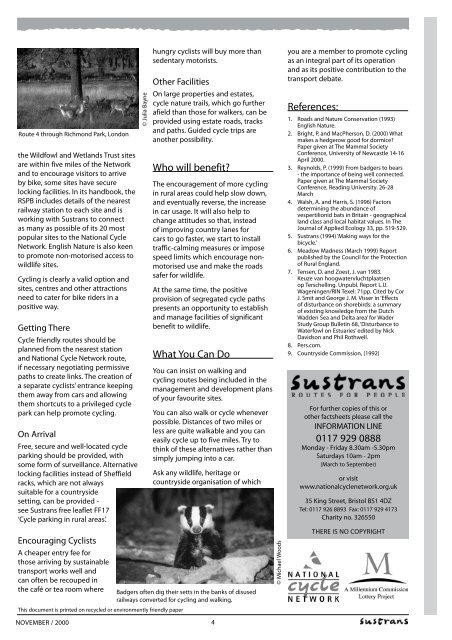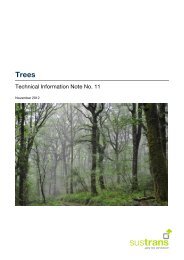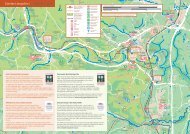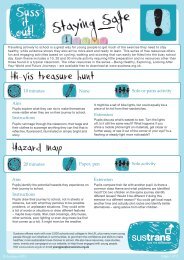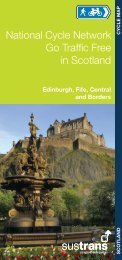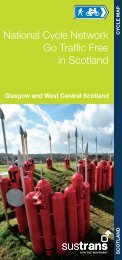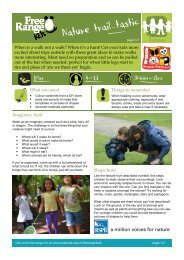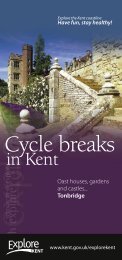Biodiversity Action Plan for the National Cycle Network ... - Sustrans
Biodiversity Action Plan for the National Cycle Network ... - Sustrans
Biodiversity Action Plan for the National Cycle Network ... - Sustrans
You also want an ePaper? Increase the reach of your titles
YUMPU automatically turns print PDFs into web optimized ePapers that Google loves.
Route 4 through Richmond Park, London<br />
<strong>the</strong> Wildfowl and Wetlands Trust sites<br />
are within five miles of <strong>the</strong> <strong>Network</strong><br />
and to encourage visitors to arrive<br />
by bike, some sites have secure<br />
locking facilities. In its handbook, <strong>the</strong><br />
RSPB includes details of <strong>the</strong> nearest<br />
railway station to each site and is<br />
working with <strong>Sustrans</strong> to connect<br />
as many as possible of its 20 most<br />
popular sites to <strong>the</strong> <strong>National</strong> <strong>Cycle</strong><br />
<strong>Network</strong>. English Nature is also keen<br />
to promote non-motorised access to<br />
wildlife sites.<br />
Cycling is clearly a valid option and<br />
sites, centres and o<strong>the</strong>r attractions<br />
need to cater <strong>for</strong> bike riders in a<br />
positive way.<br />
Getting There<br />
<strong>Cycle</strong> friendly routes should be<br />
planned from <strong>the</strong> nearest station<br />
and <strong>National</strong> <strong>Cycle</strong> <strong>Network</strong> route,<br />
if necessary negotiating permissive<br />
paths to create links. The creation of<br />
a separate cyclists’ entrance keeping<br />
<strong>the</strong>m away from cars and allowing<br />
<strong>the</strong>m shortcuts to a privileged cycle<br />
park can help promote cycling.<br />
On Arrival<br />
Free, secure and well-located cycle<br />
parking should be provided, with<br />
some <strong>for</strong>m of surveillance. Alternative<br />
locking facilities instead of Sheffield<br />
racks, which are not always<br />
suitable <strong>for</strong> a countryside<br />
setting, can be provided -<br />
see <strong>Sustrans</strong> free leaflet FF17<br />
‘<strong>Cycle</strong> parking in rural areas’.<br />
Encouraging Cyclists<br />
A cheaper entry fee <strong>for</strong><br />
those arriving by sustainable<br />
transport works well and<br />
can often be recouped in<br />
<strong>the</strong> café or tea room where<br />
© Julia Bayne<br />
This document is printed on recycled or environmently friendly paper<br />
hungry cyclists will buy more than<br />
sedentary motorists.<br />
O<strong>the</strong>r Facilities<br />
On large properties and estates,<br />
cycle nature trails, which go fur<strong>the</strong>r<br />
afield than those <strong>for</strong> walkers, can be<br />
provided using estate roads, tracks<br />
and paths. Guided cycle trips are<br />
ano<strong>the</strong>r possibility.<br />
Who will benefit?<br />
The encouragement of more cycling<br />
in rural areas could help slow down,<br />
and eventually reverse, <strong>the</strong> increase<br />
in car usage. It will also help to<br />
change attitudes so that, instead<br />
of improving country lanes <strong>for</strong><br />
cars to go faster, we start to install<br />
traffic-calming measures or impose<br />
speed limits which encourage nonmotorised<br />
use and make <strong>the</strong> roads<br />
safer <strong>for</strong> wildlife.<br />
At <strong>the</strong> same time, <strong>the</strong> positive<br />
provision of segregated cycle paths<br />
presents an opportunity to establish<br />
and manage facilities of significant<br />
benefit to wildlife.<br />
What You Can Do<br />
You can insist on walking and<br />
cycling routes being included in <strong>the</strong><br />
management and development plans<br />
of your favourite sites.<br />
You can also walk or cycle whenever<br />
possible. Distances of two miles or<br />
less are quite walkable and you can<br />
easily cycle up to five miles. Try to<br />
think of <strong>the</strong>se alternatives ra<strong>the</strong>r than<br />
simply jumping into a car.<br />
Ask any wildlife, heritage or<br />
countryside organisation of which<br />
Badgers often dig <strong>the</strong>ir setts in <strong>the</strong> banks of disused<br />
railways converted <strong>for</strong> cycling and walking.<br />
© Michael Woods<br />
you are a member to promote cycling<br />
as an integral part of its operation<br />
and as its positive contribution to <strong>the</strong><br />
transport debate.<br />
References:<br />
1. Roads and Nature Conservation (1993)<br />
English Nature.<br />
2. Bright, P. and MacPherson, D. (2000) What<br />
makes a hedgerow good <strong>for</strong> dormice?<br />
Paper given at The Mammal Society<br />
Conference, University of Newcastle 14-16<br />
April 2000.<br />
3. Reynolds, P. (1999) From badgers to bears<br />
- <strong>the</strong> importance of being well connected.<br />
Paper given at The Mammal Society<br />
Conference, Reading University. 26-28<br />
March<br />
4. Walsh, A. and Harris, S. (1996) Factors<br />
determining <strong>the</strong> abundance of<br />
vespertilionid bats in Britain - geographical<br />
land class and local habitat values. In The<br />
Journal of Applied Ecology 33, pp. 519-529.<br />
5. <strong>Sustrans</strong> (1994) ‘Making ways <strong>for</strong> <strong>the</strong><br />
bicycle.’<br />
6. Meadow Madness (March 1999) Report<br />
published by <strong>the</strong> Council <strong>for</strong> <strong>the</strong> Protection<br />
of Rural England.<br />
7. Tensen, D. and Zoest, J. van 1983.<br />
Keuze van hoogwatervluchtplaatsen<br />
op Terschelling. Unpubl. Report L.U.<br />
Wageningen/RIN Texel: 71pp. Cited by Cor<br />
J. Smit and George J. M. Visser in ‘Effects<br />
of disturbance on shorebirds: a summary<br />
of existing knowledge from <strong>the</strong> Dutch<br />
Wadden Sea and Delta area’ <strong>for</strong> Wader<br />
Study Group Bulletin 68, ‘Disturbance to<br />
Waterfowl on Estuaries’ edited by Nick<br />
Davidson and Phil Rothwell.<br />
8. Pers.com.<br />
9. Countryside Commission, (1992)<br />
For fur<strong>the</strong>r copies of this or<br />
o<strong>the</strong>r factsheets please call <strong>the</strong><br />
INFORMATION LINE<br />
0117 929 0888<br />
Monday - Friday 8.30am -5.30pm<br />
Saturdays 10am - 2pm<br />
(March to September)<br />
or visit<br />
www.nationalcyclenetwork.org.uk<br />
35 King Street, Bristol BS1 4DZ<br />
Tel: 0117 926 8893 Fax: 0117 929 4173<br />
Charity no. 326550<br />
THERE IS NO COPYRIGHT<br />
NOVEMBER / 2000<br />
4


